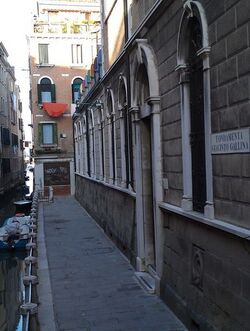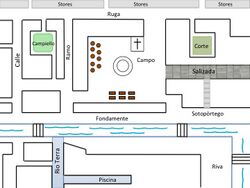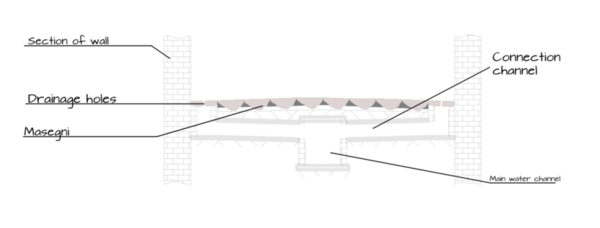Street
| Please help improve this article by expanding it. |
| This page is incomplete. Please edit the article and add some extra content. |
This article contains information about a typical Venetian street.

A street in Venice is typically paved with large stones referred to as masegni. The city's utilities and waste water conduits typically run underneath the pavement of the streets. This is one of several reasons that the maintenance performed by the city is so thorough.
Classification
Venetian Streets are given names for different reasons. For the most part names are derived from historic events, adjacent landmarks, or the type of buildings that are found on the street. While each street has an individual name, all streets can be classified into one of the following 27 categories.[1]

- Barbaria
- Bocca
- Borgoloco
- Calle
- Campazzo
- Campiello
- Campo
- Corte
- Cortesela
- Crosera
- Fondamenta
- Merceria
- Paludo
- Pescaria
- Piazzale
- Piazzeta
- Piscina
- Ramo
- Rio Terà
- Riva
- Ruga
- Rugheta
- Salizada
- Sotopòrtego
- Strada
- Via
Anatomy of a Street

The picture to the right shows a cross section of a typical Venetian street. The foundation starts with naturally occurring back-fill material which is compacted and leveled before adding a minimum 10 cm of a combination mixture of sand and lime stone. The next component of a street underneath the foundation and parallel with the street is a water collection channel known as a Colletore. Running alongside this channel are all necessary utilities. Lastly,Masegni stones are layed down in a process known in Venetian as posa which translates to "the laying down of". During this process, the joints between stones are filled with a Venetian Mortar known as cocon or dirt. While laying down these stones in one of the numerous Venetian street layouts, workers generate a slope of 1.5 degrees to allow for water run off towards a canal or caditoia[3].
For more information on paving procedures and street restoration see the street maintenance and stone Pavement pages.
Maximum Capacity of a Street
The theoretical capacity of each street we count on can be calculated with a simplified area calculation. Although traffic flow is usually compared to a fluid flowing through pipes, the capacity of a street is directly influenced by the surface area available for pedestrians to walk on top of. Following this area comparison, each pedestrian can be represented by a square portion of the street that they would occupy while walking on the street. One dimension of this square is defined by the shoulder width of the person plus a distance that represents the individual’s comfortable personal space. The other dimension is determined by the stride length of the pedestrian. The comfortable personal space for most Venetians is twenty-five centimeters.
See also
References
- ↑ Venice Backstage. http://www.venicebackstage.org/en/
- ↑ Insula pdf
- ↑ Insula pdf
Bibliography
- Finn, Paul; Hutchinson, Katie; Ouellette, Jesse; Muller, Ryan. The Building Blocks of Venice: Preserving knowledge of a city's infrastructure and maintenance. Worcester Ma. Worcester Polytechnic Institute.2011
- Brofford, Kelsey; Larkins, Riley; Rovayo, Luis; Shea, Alexandra. Boats and Bottle Necks: Improving Mobility in Venice. Worcester Ma. Worcester Polytechnic Institute.2013